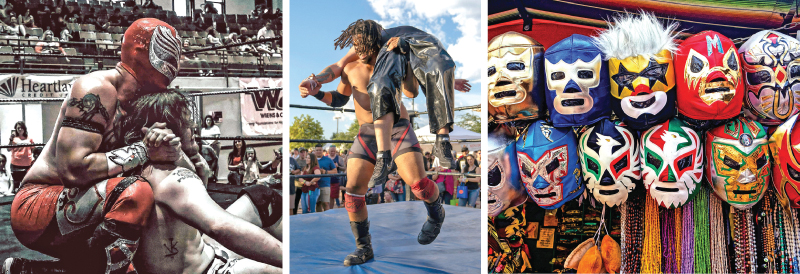 Professional wrestling is a form of sports entertainment and a style of wrestling that could be described as performance art. Since matches are choreographed and the outcomes are pre-determined, pro wrestling is often derided as being fake, but this downplays the remarkable talent, effort, and level of production put into the performances.
Professional wrestling is a form of sports entertainment and a style of wrestling that could be described as performance art. Since matches are choreographed and the outcomes are pre-determined, pro wrestling is often derided as being fake, but this downplays the remarkable talent, effort, and level of production put into the performances.
Though it is far past its heyday, professional wrestling has made quite a resurgence in recent years, with millions of viewers tuning in from around the world.
Despite all the show-business, professional wrestling is very real in the sense that behind the simulated Hollywood fantasy lies genuine danger. Matches are “fake” only in that they have predetermined outcomes — wrestlers are more like stunt performers than actors. They act out scenes physically and in real time, with no second takes. Training as a professional involves learning how to deliver moves safely and how to take bumps in a way that protects the body.
However, the hits still hurt, and while moves are designed to look more devastating than they are, injuries are common. Broken bones, concussions, and even paralysis have occurred in the ring. Wrestlers literally put their lives in each other’s hands every night, and even the smallest mistake can have serious consequences.
Though wrestling had been around for ages, literally since the Greco-Roman times, modern professional wrestling as we know it traces its roots to ‘Catch Wrestling’, a grappling style developed by British carnival promoters in the late 19th century. It introduced many of the rules that we associate with wrestling today, such as having far fewer restrictions on holds, and winning through pinning or submission.
Gained popularity
It gained popularity in America as a legitimate sport before evolving in the early 20th century into a “work,” where match outcomes were decided in advance. This was done over time for a variety of reasons, such as fewer injuries, showier moves, and shorter match times, which most audiences preferred. This drastically upped the entertainment value of matches. Wrestlers were cast as “faces” (heroes) or “heels” (villains) to encourage crowd participation and emotional investment.
From these origins grew a network of regional wrestling promotions across the United States, which banded together under the National Wrestling Alliance (NWA). The NWA coordinated championship titles and facilitated national tours for top talent. This territory system allowed local fan bases to thrive while ensuring that major stars gained broader exposure. In 1963, Capitol Wrestling Corporation broke away from the NWA and eventually became the World Wide Wrestling Federation (WWWF)—later renamed World Wrestling Federation (WWF) and now World Wrestling Entertainment (WWE).
Japanese wrestling
While WWE was making waves in the West, Japan was developing its own unique wrestling culture. Known locally as puroresu, Japanese pro wrestling emphasizes athletic realism and discipline. Promotions like New Japan Pro-Wrestling (NJPW) and All Japan Pro Wrestling (AJPW) are known for their “strong style,” where strikes and slams are executed with full force to emphasize realism. Japanese wrestling tends to treat matches more like legitimate athletic contests, with less focus on soap opera-style drama and more on long-term storytelling and in-ring performance.
Wrestlers such as Antonio Inoki, Mitsuharu Misawa, and Kazuchika Okada are considered legends, known for their endurance and respect for the sport.
Pro wrestling in Mexico, known as Lucha Libre, is its own unique scene, characterized by high-flying manoeuvers, rapid sequences, and masked wrestlers, or luchadores, who often adopt superhero-like personas. Masks hold deep symbolic meaning, representing honour, mystique, and legacy. Promotions such as CMLL and AAA are major forces in the industry, with matches often featuring técnicos (heroes) vs. rudos (villains).
Lucha libre’s influence can be seen worldwide, especially in the U.S. and Japan, and many international stars, including Rey Mysterio and Eddie Guerrero, have roots in Mexican wrestling.





